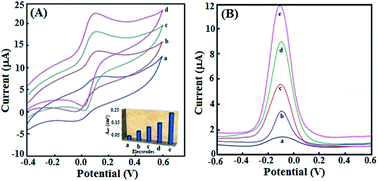Gold nanorods vs. gold nanoparticles: application in electrochemical sensing of cytosine β-d-arabinoside using metal ion mediated molecularly imprinted polymer†
Abstract
The determination of an anticancer drug (cytosine arabinoside, Ara-C) in body fluids is very important due to its pharmaceutical and clinical significance. This drug is widely used for the treatment of cancer patients suffering from acute myeloid leukemia. In this study, a typical surface imprinting approach was adopted for the immobilization of imprinted nano film on a pencil graphite electrode decorated with gold nanorods/gold nano particles. For this, gold nanorods were attached first onto the electrode surface followed by their modification with a pre-polymer mixture. Herein, monomeric molecules (N-methacryloyl-L-cysteine) were coated via Au–S links on an electrode surface that had undergone metal ion mediated molecularly imprinted polymerization, in the presence of a template (Ara-C), crosslinker (ethylene glycol dimethacrylate) and initiator [2,2′-azobis(isobutyronitrile)]. Similar modification was carried out on a gold nanoparticles immobilized electrode for comparison, in terms of differential pulse anodic stripping voltammetric transduction and measurement sensitivity. An extended imprinting polymer (template-free) coating on the longitudinal surface of the gold nanorods was found to reveal higher electrode kinetics. This produced a better signal with enhanced detection sensitivity (k = 1.36 × 10−2, linearity range = 1.00–126.71 ng mL−1, limit of detection = 0.19 ng mL−1) of the drug than those (k = 1.75 × 10−3, linearity range = 3.00–107.21 ng mL−1, limit of detection = 0.75 ng mL−1) realized with a gold nanoparticles decorated imprinted polymer layer compressed in spherical curved space. Consequently, the proposed gold nanorods-based imprinted sensor is adjudged to be better in helping to monitor a dose-dependent antiproliferative effect of a drug and its supplementation in chemotherapy.



 Please wait while we load your content...
Please wait while we load your content...